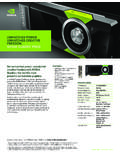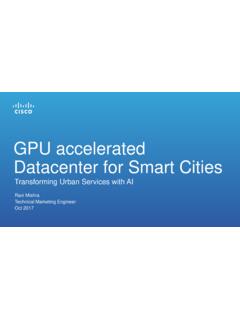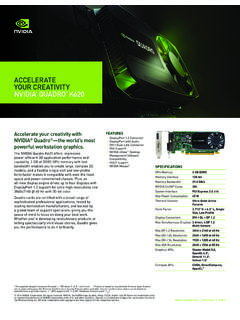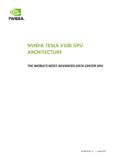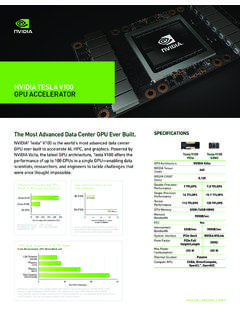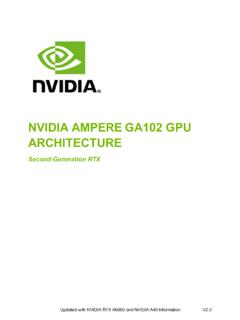Transcription of NVIDIA AMPERE GA102 GPU ARCHITECTURE
1 NVIDIA AMPERE GA102 GPU ARCHITECTURE Second- generation RTX NVIDIA AMPERE GA102 GPU ARCHITECTURE ii Table of Contents Introduction 5 GA102 Key Features 7 2x FP32 Processing 7 Second- generation RT Core 7 Third- generation Tensor Cores 8 GDDR6X and GDDR6 Memory 8 Third- generation NVLink 8 PCIe Gen 4 9 AMPERE GPU ARCHITECTURE In-Depth 10 GPC, TPC, and SM High-Level ARCHITECTURE 10 ROP Optimizations 11 GA10x SM ARCHITECTURE 11 2x FP32 Throughput 12 Larger and Faster Unified Shared Memory and L1 Data Cache 13 Performance Per Watt 16 Second- generation Ray Tracing Engine in GA10x gpus 17 AMPERE ARCHITECTURE RTX Processors in Action 19 GA10x GPU Hardware Acceleration for Ray-Traced Motion Blur 20 Third- generation Tensor Cores in GA10x gpus 24 Comparison of Turing vs GA10x GPU Tensor Cores 24 NVIDIA AMPERE ARCHITECTURE Tensor Cores Support New DL Data Types 26 Fine-Grained Structured Sparsity 26 NVIDIA DLSS 8K 28 GDDR6X Memory 30 RTX IO 32 Introducing NVIDIA RTX IO 33 How NVIDIA RTX IO Works 34 Display and Video Engine 38 DisplayPort with DSC 38 HDMI
2 With DSC 38 Fifth generation NVDEC - Hardware-Accelerated Video Decoding 39 AV1 Hardware Decode 40 Seventh generation NVENC - Hardware-Accelerated Video Encoding 40 NVIDIA AMPERE GA102 GPU ARCHITECTURE iii Conclusion 42 Appendix A - Additional GeForce GA10x GPU Specifications 44 GeForce RTX 3090 44 GeForce RTX 3070 46 Appendix B - New Memory Error Detection and Replay (EDR) Technology 49 Appendix C - RTX A6000 GPU Performance 50 List of Figures Figure 1. AMPERE GA10x ARCHITECTURE - A Giant Leap .. 6 Figure 2. GA102 Full GPU with 84 SMs ..10 Figure 3. GA10x Streaming Multiprocessor (SM) ..12 Figure 4. NVIDIA AMPERE GA10x ARCHITECTURE Power Efficiency ..16 Figure 5. GeForce RTX 3080 vs GeForce RTX 2080 Super RT Performance.
3 17 Figure 6. Second- generation RT Core in GA10x gpus ..18 Figure 7. Turing RTX Technology Improves Performance ..19 Figure 8. AMPERE ARCHITECTURE RTX Technology Further Improves Performance ..20 Figure 9. AMPERE ARCHITECTURE Motion Blur Hardware Acceleration ..21 Figure 10. Basic Ray Tracing vs Ray Tracing with Motion Blur ..22 Figure 11. Rendering Without vs With Motion Blur on GA10x ..23 Figure 12. AMPERE ARCHITECTURE Tensor Core vs Turing Tensor Figure 13. Fine-Grained Structured Sparsity ..27 Figure 14. Watch Dogs: Legion with 8K DLSS compared to 4K and 1080p resolution..28 Figure 15. Built for 8K Gaming ..29 Figure 16. GDDR6X Improved Performance and Efficiency using PAM4 Signaling ..30 Figure 17. GDDR6X New Signaling, New Coding, New Algorithms.
4 31 Figure 18. Games Bottlenecked by Traditional I/O ..32 Figure 19. Compressed Data Needed, but CPU Cannot Keep Up ..33 Figure 20. RTX IO Delivers 100X Throughput, 20X Lower CPU Utilization ..34 Figure 21. Level Load Time Comparison ..35 Figure 22. NVIDIA A40 data center GPU for visual computing ..36 Figure 23. Video Decode and Encode Formats Supported on GA10x gpus ..39 Figure 24. GA104 Full GPU with 48 SMs ..46 Figure 25. Old Overclocking Method vs Overclocking with EDR ..49 Figure 26. SPEC viewperf 2020 Performance - RTX A6000 vs RTX 6000 ..50 Figure 27. Rendering Performance - RTX A6000 vs RTX 6000 ..51 Figure 28. HPC Performance - RTX A6000 vs RTX 6000 ..51 Figure 29. Deep Learning Performance - RTX A6000 vs RTX 6000.
5 52 List of Tables Table 1. Comparative X-Factors for FP32 Throughput ..13 Table 2. GeForce RTX 3080 vs GeForce RTX 2080 / 2080 Super ..14 NVIDIA AMPERE GA102 GPU ARCHITECTURE iv Table 3. NVIDIA RTX A6000 and NVIDIA A40 Specs ..15 Table 4. Ray Tracing Feature Comparison ..18 Table 5. Comparing RTX A6000 vs RTX 6000 Motion Blur Rendering Time ..23 Table 6. Comparison of NVIDIA Turing vs AMPERE ARCHITECTURE Tensor Core ..25 Table 7. DisplayPort Versions - Spec Comparison ..38 Table 8 . HDMI Versions - Spec Comparison ..38 Table 9. Comparison of GeForce RTX 3090 to NVIDIA Titan RTX ..44 Table 10. Comparison of GeForce RTX 3070 to GeForce RTX 2070 Super ..47 Introduction to the NVIDIA AMPERE GA102 GPU ARCHITECTURE NVIDIA AMPERE GA102 GPU ARCHITECTURE 5 Introduction Since inventing the world s first GPU (Graphics Processing Unit) in 1999, NVIDIA gpus have been at the forefront of 3D graphics and GPU-accelerated computing.
6 Each NVIDIA GPU ARCHITECTURE is carefully designed to provide breakthrough levels of performance and efficiency. The family of new NVIDIA AMPERE ARCHITECTURE gpus is designed to accelerate many different types of computationally intensive applications and workloads. The first NVIDIA AMPERE ARCHITECTURE GPU, the A100, was released in May 2020 and provides tremendous speedups for AI training and inference, HPC workloads, and data analytics applications. The A100 GPU is described in detail in the NVIDIA A100 GPU Tensor Core ARCHITECTURE Whitepaper. The newest members of the NVIDIA AMPERE ARCHITECTURE GPU family, GA102 and GA104, are described in this whitepaper. GA102 and GA104 are part of the new NVIDIA GA10x class of AMPERE ARCHITECTURE gpus .
7 GA10x gpus build on the revolutionary NVIDIA Turing GPU ARCHITECTURE . Turing was the world s first GPU ARCHITECTURE to offer high performance real-time ray tracing, AI-accelerated graphics, energy-efficient inference acceleration for the data center, and professional graphics rendering all in one product. GA10x gpus add many new features and deliver significantly faster performance than Turing gpus . In addition, GA10x gpus are carefully crafted to provide the best performance per area and energy efficiency for traditional graphics workloads, and even more so for real-time ray tracing workloads. Compared to the Turing GPU ARCHITECTURE , the NVIDIA AMPERE ARCHITECTURE is up to faster in traditional raster graphics workloads and up to 2x faster in ray tracing.
8 GA102 is the most powerful AMPERE ARCHITECTURE GPU in the GA10x lineup and is used in the GeForce RTX 3090, GeForce RTX 3080, NVIDIA RTX A6000, and the NVIDIA A40 data center GPU. The GeForce RTX 3070 GPU uses the new GA104 GPU. The GeForce RTX 3090 is the highest performing GPU in the GeForce RTX lineup and has been built for 8K HDR gaming. With 10496 CUDA Cores, 24GB of GDDR6X memory, and the new DLSS 8K mode enabled, it can run many games at 8K@60 fps. The GeForce RTX 3080 provides up to 2x the performance of the GeForce RTX 2080, delivering the greatest generational leap of any GPU that has ever been made. The GeForce RTX 3070 offers performance that rivals NVIDIA s previous generation flagship GPU, the GeForce RTX 2080 Ti.
9 New HDMI and AV1 decode features in GA10x gpus allow users to stream content at 8K with HDR. The NVIDIA RTX A6000 combines 84 second- generation RT Cores, 336 third- generation Tensor Cores, and 10,752 CUDA Cores with 48 GB of fast GDDR6 for accelerated rendering, graphics, AI, and compute performance. Two RTX A6000s can be connected with NVIDIA NVLink to provide 96 GB of combined GPU memory for handling extremely large rendering, AI, VR, and visual computing workloads. In total, RTX A6000 delivers the key capabilities designers, engineers and artists need to tackle the most complex workloads from their desktop workstation. Introduction to the NVIDIA AMPERE GA102 GPU ARCHITECTURE NVIDIA AMPERE GA102 GPU ARCHITECTURE 6 Finally, the NVIDIA A40 GPU is an evolutionary leap in performance and multi-workload capabilities for the data center, combining best-in-class professional graphics with powerful compute and AI acceleration to meet today s design, creative, and scientific challenges.
10 Including the same core counts and memory size as the RTX A6000, the A40 will power the next generation of virtual workstations and server-based workloads. NVIDIA A40 is up to 2X more power efficient than the previous generation , and it brings state-of-the-art features for ray-traced rendering, simulation, virtual production, and more to professionals. Figure 1. AMPERE GA10x ARCHITECTURE - A Giant Leap GA102 Key Features NVIDIA AMPERE GA102 GPU ARCHITECTURE 7 GA102 Key Features Fabricated on Samsung s 8nm 8N NVIDIA Custom Process, the NVIDIA AMPERE ARCHITECTURE -based GA102 GPU includes billion transistors with a die size of mm2. Like all GeForce RTX gpus , at the heart of GA102 lies a processor that contains three different types of compute resources: Programmable Shading Cores, which consist of NVIDIA CUDA Cores RT Cores, which accelerate Bounding Volume Hierarchy (BVH) traversal and intersection of scene geometry during ray tracing Tensor Cores, which provide enormous speedups for AI neural network training and inferencing A full GA102 GPU incorporates 10752 CUDA Cores, 84 second- generation RT Cores, and 336 third- generation Tensor Cores, and is the most powerful consumer GPU NVIDIA has ever built for graphics processing.

